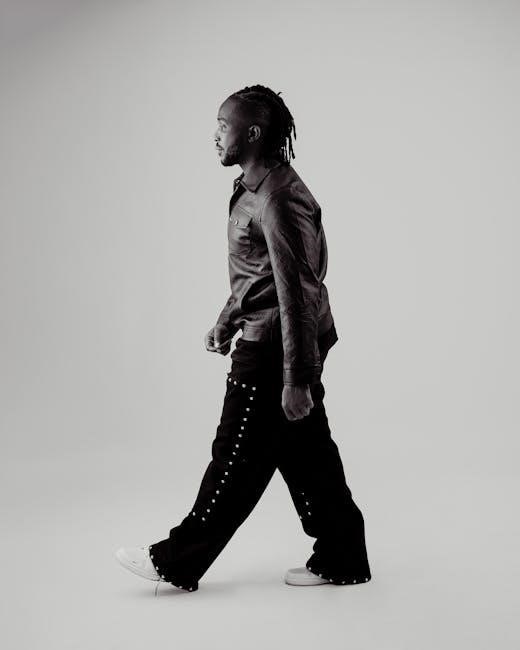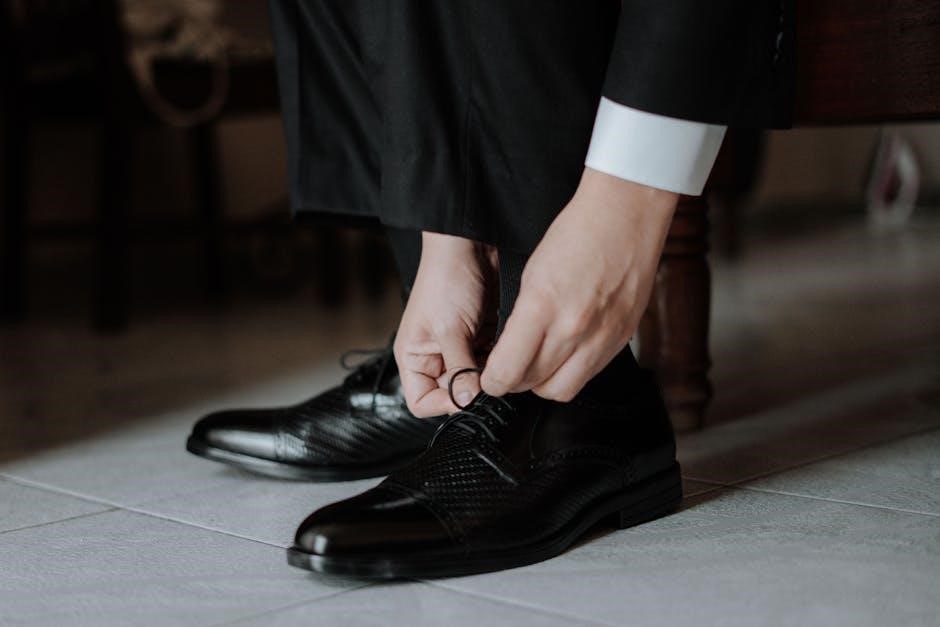
Finding the perfect fit is key to style and comfort. This guide helps you navigate men’s shirt sizes, ensuring a tailored look for every body type and preference.

Understanding Shirt Measurements
Accurate shirt measurements are crucial for the perfect fit. They typically include chest, neck, and sleeve lengths, ensuring comfort and style tailored to your body dimensions.
Importance of Accurate Measurements
Accurate measurements are essential for ensuring a comfortable and flattering fit. Ill-fitting shirts can restrict movement, appear unflattering, or compromise style. Proper measurements ensure the shirt sits well on the body, balancing comfort and aesthetics. Chest, neck, and sleeve measurements are critical, as they directly impact how the shirt drapes and fits. Incorrect sizing can lead to alterations or returns, making precise measurements a time-saving investment. Whether for casual or formal wear, accurate sizing ensures confidence and style, making it a cornerstone of a well-curated wardrobe.
Key Measurement Points: Chest, Neck, and Sleeve
The chest, neck, and sleeve measurements are the foundation of determining shirt size; The chest measurement, taken around the fullest part of the chest, ensures the shirt isn’t too tight or loose. The neck measurement, taken at the base of the neck, affects the collar fit. Sleeve length, measured from the center back to the wrist, ensures proper arm length. These three measurements provide a comprehensive understanding of fit, enabling accurate size selection and a comfortable, tailored look. Together, they form the core of men’s shirt sizing, ensuring both style and functionality.

How to Take Your Measurements
To ensure accuracy, use a flexible tape measure. Stand upright, take chest measurements under the armpits, neck circumference at the base, and sleeve length from the neck center to the wrist for the perfect fit.
Measuring Chest Size
To measure your chest size accurately, wrap a flexible tape measure around the fullest part of your chest, keeping it level and parallel to the floor. Ensure the tape is not too tight or too loose. Stand upright with your arms at your sides. The measurement should be taken just under the armpits, across the shoulder blades, and around the back. This will give you the circumference used to determine your shirt size. For reference, typical chest measurements for men range from 36.5 to 49 inches, corresponding to sizes from XS to 3XL. This ensures a comfortable and tailored fit.
Measuring Neck Size
To measure your neck size, wrap a flexible tape measure around the base of your neck, just above the collarbone. Keep the tape level and not too tight or loose. Stand upright with your head straight. The measurement should be taken with the tape mid-way between the back and front of your neck. Typical neck sizes for men range from 14 to 19 inches. This measurement is crucial for determining the collar size of your shirt. Ensure the tape is parallel to the floor and lies flat against the skin for an accurate reading. This helps in selecting a shirt that fits comfortably around the neck.
Measuring Sleeve Length
To measure sleeve length, start at the center back of your neck, just below the collarbone; Place the tape measure over your shoulder, following the natural curve of your arm, and extend it to your wrist. Keep your arm slightly bent for an accurate fit. The tape should run straight, not too tight or loose. Typical sleeve lengths for men range from 32 to 37 inches. This measurement ensures the shirt sleeves reach your wrist comfortably, providing a tailored appearance. Accurate sleeve length is essential for a balanced fit, as it impacts both comfort and style. Use this measurement to match your size in the shirt size chart.

Standard Men’s Shirt Size Chart
The standard men’s shirt size chart typically includes categories like Small, Medium, Large, and XL, with measurements ranging from 36.5 to 45.5 inches for chest and 41.5 to 49 inches for neck. This chart helps men select the perfect fit based on body measurements, ensuring comfort and style across various body types and preferences.
Small, Medium, Large, and XL Sizes
Men’s shirt sizes are categorized as Small, Medium, Large, and XL, with each size corresponding to specific chest and neck measurements. Small typically fits chests measuring 36.5–38.5 inches and necks 14–14.5 inches. Medium accommodates chests of 38.5–40 inches and necks 15–15.5 inches. Large suits chests 40.5–42 inches and necks 16–16.5 inches. XL is designed for chests 42–44 inches and necks 17–17.5 inches. These standard measurements ensure a balanced fit, but variations may occur across brands. Always compare your measurements with the size chart to select the best fit for your body type and preferred style.
Understanding Numerical Measurements
Numerical measurements in men’s shirt sizing refer to specific body dimensions, primarily chest and neck circumference, to determine the best fit. Chest measurements typically range from 36.5 to 45.5 inches, while neck sizes range from 14 to 17.5 inches. These measurements are standardized across brands but may vary slightly; For example, a medium shirt usually fits a chest of 38.5–40 inches and a neck of 15–15.5 inches. Understanding these numerical values helps in selecting the correct size, ensuring comfort and style. Always compare your measurements with the brand’s size chart for accuracy, as slight differences may exist between brands.
Differences in Fit Types
Men’s shirts come in various fits, including slim, regular, relaxed, and athletic. Each offers a unique silhouette, catering to different body types and personal style preferences.
Slim Fit vs. Regular Fit
A slim-fit shirt is tailored closely to the body, offering a modern, streamlined look. It is ideal for slimmer builds or those who prefer a fashionable, contemporary style. Regular-fit shirts, on the other hand, provide a classic, comfortable cut with more room in the chest and sleeves, making them suitable for a broader range of body types. Slim-fit shirts often require precise measurements to ensure comfort, while regular-fit shirts are more forgiving and versatile for everyday wear. Understanding these differences helps in selecting the right fit based on personal style and body type.
Relaxed Fit vs. Athletic Fit
A relaxed-fit shirt offers a loose, comfortable cut, providing ample room across the chest, shoulders, and sleeves. It is perfect for casual wear and suits men with broader or more muscular builds. An athletic-fit shirt is designed for those with defined physiques, featuring a slightly tapered silhouette to accentuate the body while maintaining ease of movement. Unlike slim or regular fits, athletic-fit shirts balance style with functionality, making them ideal for active individuals. Both styles cater to different preferences, ensuring a comfortable and flattering fit for various lifestyles and body types.

International Sizing
Men’s shirt sizes vary globally, with US, EU, and UK sizes differing significantly; Understanding these differences is crucial for selecting the right fit. This guide provides comparisons and numerical measurements for each region, ensuring accuracy and confidence when shopping internationally. Use these size charts to find your perfect fit across borders, whether you’re comparing US, EU, or UK sizes. Accurate measurements ensure a tailored look and comfort regardless of regional sizing standards.
US, EU, and UK Size Comparisons
Understanding the differences in sizing between US, EU, and UK standards is essential for international shopping. US sizes typically range from Small to 3XL, while EU sizes are numerical, reflecting chest measurements in centimeters. UK sizes align closely with EU measurements but are labeled differently. For example, a US Medium often corresponds to an EU 48-50 and a UK 38-40. These comparisons vary slightly between brands, so checking specific size charts is crucial. Numerical measurements provide a universal reference, helping bridge regional differences. Always compare your body measurements to the size chart for accurate fit, ensuring comfort and style across borders.
Converting Sizes Across Regions
Converting shirt sizes between US, EU, and UK requires understanding their numeric and alphabetic systems. EU sizes are based on chest measurements in centimeters, while US and UK sizes use inches. For example, a US Medium (chest 40.5–42″) aligns with EU 50–52 cm and UK 40–42″. Slim-fit styles may differ slightly. To convert, match your chest measurement to the corresponding size in the target region. Always refer to the specific brand’s size chart, as variations exist. Using numeric measurements ensures accuracy, making it easier to shop across borders and find the perfect fit for your body type and preferred style.

Fabric and Seasonality
Fabric weight affects fit, with lighter materials for summer and heavier for winter. Seasonal variations ensure comfort and style, perfect for any time of year.
How Fabric Weight Affects Fit
Fabric weight plays a significant role in how a shirt fits and feels. Heavier fabrics, like wool or thick cotton, provide structure and drape differently compared to lightweight materials such as linen or silk. Slim-fit shirts in heavier fabrics may feel tighter, while the same style in lighter fabrics offers a more relaxed drape. Seasonal fabrics, such as breathable cotton for summer or thermal blends for winter, also influence comfort and fit. Choosing the right fabric weight ensures optimal comfort and style, making it essential to consider when selecting shirt sizes for different occasions and weather conditions.
Seasonal Variations in Sizing
Seasonal variations in sizing occur due to changes in fabric weight and fit preferences. Summer shirts often use lightweight, breathable fabrics like linen or cotton, which drape loosely for comfort in heat. Winter shirts may use thicker, insulating fabrics like flannel or wool, which can fit slightly tighter due to their weight. Additionally, seasonal trends may influence sizing, with summer styles often offering a relaxed fit and winter styles leaning toward slim or tailored cuts. Understanding these variations helps in selecting the right size for optimal comfort and style across different seasons.

Common Fit Issues and Solutions
Shirts may feel too tight or loose, or sleeves may be misaligned. Adjusting sizes or opting for slim/relaxed fits often resolves these issues for a better drape.
Too Tight or Too Loose: Adjusting Sizes
If a shirt feels too tight, it may restrict movement and look unflattering. Conversely, a shirt that’s too loose can appear baggy and lack definition. To resolve this, compare your body measurements with the size chart to ensure accuracy. If you’re between sizes, consider sizing up for a more comfortable fit. Slim-fit shirts are ideal for those with lean builds, while relaxed-fit shirts accommodate broader frames. Pay attention to fabric weight, as heavier materials may fit tighter. Ultimately, personal preference plays a significant role in choosing the perfect fit. Always double-check measurements to avoid sizing mismatches and ensure optimal comfort and style.
Addressing Sleeve and Shoulder Fit
Sleeve and shoulder fit are crucial for a shirt to look tailored. Ensure sleeves are neither too long nor too short—ideally, they should reach the base of your thumb. Shoulder seams should align with your natural shoulder line, avoiding slouching or tightness. If sleeves are too tight, mobility is restricted, while loose sleeves can appear bulky. For broader shoulders, consider athletic-fit shirts, which offer more room. Slim-fit shirts are better for narrower frames. Always compare your measurements to the size chart and opt for a fit that balances comfort and style, ensuring the shirt drapes smoothly across your shoulders and arms.

Step-by-Step Guide to Choosing the Right Size
Measure your chest, neck, and sleeves, then compare to size charts. Consider fit type—slim, regular, or relaxed. Match your measurements to the closest size for the best fit.
Comparing Body Measurements to Size Charts
Accurate body measurements are crucial for selecting the right shirt size. Measure your chest, neck, and sleeve length, then align these with the size chart provided. Chest measurements typically range from 36.5 to 45.5 inches, while neck sizes vary from 14 to 19 inches. Sleeve length should match your arm length from the center back to the wrist. Compare these measurements to the chart, ensuring they fall within the specified ranges for each size. Consider fabric weight and seasonal variations, as these can affect fit. Slim-fit shirts may require smaller sizes, while relaxed fits offer more room. Always cross-reference your measurements with the chart to ensure the best fit.
Considering Personal Fit Preferences
Personal fit preferences play a significant role in choosing the right shirt size. Some men prefer a slim, tailored look, while others opt for a relaxed, comfortable fit. Consider your lifestyle and how you want the shirt to feel. Slim-fit shirts are ideal for a modern, streamlined appearance, while regular or relaxed fits offer more room for ease. Fabric weight and drape also influence comfort. Seasonal variations may require adjustments, with lighter fabrics for summer and heavier ones for winter. Ultimately, your fit preference should align with your body type and personal style to ensure confidence and comfort in your choice.

How Shirt Styles Affect Fit
Different shirt styles impact fit, with dress shirts offering a tailored look and casual styles providing relaxed comfort. Slim-fit shirts hug the body, while polos and T-shirts vary in snugness, ensuring a fit that matches your lifestyle and build.
Dress Shirts vs. Casual Shirts
Dress shirts and casual shirts differ significantly in fit and purpose. Dress shirts, designed for formal occasions, typically feature a slimmer, more tailored cut, emphasizing a precise chest and shoulder fit. Casual shirts, such as polos or T-shirts, offer a relaxed silhouette, prioritizing comfort and ease of movement. The key distinction lies in their measurements, with dress shirts often requiring more accurate sizing to avoid a boxy or overly tight appearance. Understanding these differences helps in selecting the right style for specific occasions, ensuring both comfort and a polished look.
Polo Shirts and T-Shirts: Fit Differences
Polo shirts and T-shirts vary in fit, catering to different styles and needs; Polo shirts typically offer a slightly tailored fit, with a defined collar and button placket, while T-shirts provide a more relaxed, basic silhouette. The key difference lies in their construction: polos often have a bit more structure, especially around the chest and shoulders, whereas T-shirts are designed for maximum comfort with a looser fit. Understanding these distinctions helps in choosing the right style for your desired look, whether casual or slightly dressy, ensuring a comfortable and flattering fit for any occasion.

Measuring for Specific Body Types
Accurate measurements are crucial for different body types, ensuring shirts fit perfectly. Petite, average, and tall builds require tailored approaches to chest, neck, and sleeve measurements.
Petite, Average, and Tall Builds
Petite, Average, and Tall Builds
Understanding your body type is essential for a perfect fit; Petite builds require shorter sleeves and a tailored chest measurement to avoid excess fabric. Average builds balance proportions, fitting most standard sizes. Tall builds need longer sleeves and slightly extended shirt lengths for comfort. Measure carefully, focusing on chest, neck, and sleeve lengths. For petites, subtract 1-2 inches from sleeve length; for tall builds, add 1-2 inches. Ensure the shirt skims the body without being too tight or loose. Adjusting measurements based on body type ensures a flattering and comfortable fit, regardless of height or build. Proper fit enhances both style and confidence.
Accommodating Broad Shoulders or Larger Waistlines
For men with broad shoulders or larger waistlines, finding the right fit requires careful consideration. Measure chest and shoulder width to ensure the shirt isn’t too tight. Look for shirts with a bit more room in the chest and shoulders, while maintaining a balanced fit through the waist. Relaxed-fit or athletic-fit shirts are ideal, as they offer extra comfort and flexibility. If sleeves feel restrictive, consider longer or adjustable cuffs. For larger waistlines, ensure the shirt length is sufficient to stay tucked in without stretching. Proper fit enhances both style and comfort, making broader frames appear streamlined and confident;
Converting Measurements to Shirt Sizes
Converting measurements to shirt sizes involves comparing chest and neck measurements to standard charts, ensuring a fit that aligns with your body type and style preferences.
Using Chest and Neck Measurements
Accurate chest and neck measurements are crucial for determining shirt size. Chest size typically ranges from 36.5 to 45.5 inches, while neck measurements range from 14 to 19 inches. These measurements correspond to sizes from XS to 3XL. For example, a chest measurement of 40.5–42 inches and a neck measurement of 44.5–46 inches typically falls under a Medium size. Always compare your measurements to the specific brand’s size chart, as sizing can vary slightly between brands. Ensuring precise measurements guarantees a comfortable and flattering fit, whether you prefer slim, regular, or relaxed styles.
Finalizing Size Selection
After comparing your chest and neck measurements to the size chart, select the size that best aligns with your body dimensions. Consider your fit preference—slim, regular, or relaxed—to ensure comfort and style. If your measurements fall between sizes, opt for the next size up for a better fit. Personal comfort and intended use (e.g., dress or casual) also influence your final choice. Double-checking reviews or brand sizing notes can help confirm your decision. The right fit enhances confidence and ensures functionality, making it essential to prioritize accuracy when finalizing your size selection.
A well-fitting shirt enhances confidence and comfort. This guide provides essential tips to help you choose the right size, ensuring a perfect fit for every occasion.
This guide provides a comprehensive overview of men’s shirt sizing, focusing on accurate measurements and fit types. Key points include understanding chest, neck, and sleeve measurements, as well as distinguishing between slim, regular, and relaxed fits. It highlights the importance of comparing body measurements to size charts and considering fabric weight and seasonal variations. The guide also addresses international sizing differences and offers tips for addressing common fit issues. By following these guidelines, men can ensure a comfortable and flattering fit, whether for casual or formal occasions. Proper measurements and size comparisons are essential for achieving the perfect shirt fit.
Final Tips for a Perfect Fit
Always measure accurately and compare your measurements to the size chart. Consider your personal fit preferences, whether slim, regular, or relaxed. Pay attention to fabric weight, as heavier fabrics may fit tighter. Ensure sleeves and shoulders align properly for a polished look. If unsure, size up slightly for comfort. Try shirts on if possible, and don’t hesitate to seek advice from retailers. Seasonal variations may affect sizing, so adjust accordingly. By following these tips, you’ll achieve a comfortable, flattering fit tailored to your unique needs and style preferences.